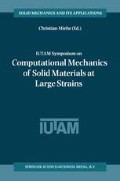Abstract
An Eulerian rate formulation of finite elastoplasticity is a composite one, in which objective Eulerian tensor rates are used. Among a large variety of objective rates, how to choose suitable ones has been one of the crucial points in finite elastoplasticity. It is realized that the foregoing composite formulation of elastoplasticity should fulfill certain criteria in order to avoid inconsistencies or contradictions.
Access this chapter
Tax calculation will be finalised at checkout
Purchases are for personal use only
Preview
Unable to display preview. Download preview PDF.
References
Bruhns, O.T., Xiao, H. and Meyers, A. (1999). Self-consistent Eulerian rate type elastoplasticity models based upon the logarithmic stress rate. Int. J. Plasticity, 15, 479–520.
Dafalias, Y.F. (1985). The plastic spin. J. Appl. Mech., 52, 865–871.
Dienes, J.K. (1979). On the analysis of rotation and stress rate in deforming bodies. Acta Mechanica, 32, 217–232.
Green, A.E. and Naghdi, P.M. (1965) A general theory of an elastic-plastic continuum. Arch. Rat. Mech. Anal., 18, 251–281.
Hill, R. (1958). A general theory of uniqueness and stability in elastic-plastic solids. J. Mech. Phys. Solids, 6, 236–249.
Hill, R. (1978). Aspects of invariance in solid mechanics. Adv. Appl. Mech., 18, 1–75.
Hoger, A. (1987). The stress conjugate to the logarithmic strain. Int. J. Solids Struct., 23, 1645–1656.
Lee, E.H. (1969). Elastic-plastic deformation at finite strains. J. Appl. Mech., 36, 1–6.
Lee, E.H., Mallett, R.L. and Wertheimer, T.B. (1983). Stress analysis for anisotropic hardening in finite deformation plasticity. J. Appl. Mech., 50, 554–560.
Lehmann, Th. (1962). Zur Beschreibung großer plasticher Formänderungen unter Berücksichtigung der Werkstoffverfestigung. Rheologica Acta, 2, 247–254.
Nagtegaal, J.C. and De Jong, J.E. (1982). Some aspects of non-isotropic work-hardening in finite strain plasticity. In: Plasticity of Metals at Finite Strain: Theory, Computation and Experiment, E.H. Lee and R.L. Mallet (eds.), Stanford University, pp.65–102.
Nemat-Nasser, S. (1982). On finite deformation elastoplasticity. Int. J. Solids Struct., 18, 857–872.
Prager, W. (1960). An elementary discussion of definitions of stress rate. Q. Appl. Math., 18, 403–407.
Simó, J.C. and Pister, K.S. (1984). Remarks on rate constitutive equations for finite deformation problem: computational implications. Comp. Meth. Appl. Mech. Engng., 46, 201–215.
Truesdell, C.A. and Noll, W. (1965). The nonlinear field theories of mechanics. In: Handbuch der Physik, S. Flügge (ed.), vol. III/3, Berlin: Springer-Verlag.
Xiao, H., Bruhns, O.T. and Meyers, A. (1997). Logarithmic strain, logarithmic spin and logarithmic rate. Acta Mechanica, 124, 89–105.
Xiao, H., Bruhns, O.T. and Meyers, A. (1998). On objective corotational rates and their defining spin tensors. Int. J. Solids Struct., 35, 4001–4014.
Xiao, H., Bruhns, O.T. and Meyers, A. (1998). Objective corotational rates and unified work-conjugacy relation between Lagrangean and Eulerian stress and strain measures. Arch. Mech., 50, 913–943.
Xiao, H., Bruhns, O.T. and Meyers, A. (2000). A consistent finite elastoplasticity theory combining additive and multiplicative decomposition of the stretching and the deformation gradient. Int. J. Plasticity, 16, 143–177.
Xiao, H., Bruhns, O.T. and Meyers, A. (2000). The choice of objective rates in finite elastoplasticity: general results on the uniqueness of the logarithmic rate. Proc. Roy. Soc. London, A 456, 1865–1882.
Author information
Authors and Affiliations
Editor information
Editors and Affiliations
Rights and permissions
Copyright information
© 2003 Springer Science+Business Media Dordrecht
About this paper
Cite this paper
Bruhns, O.T. (2003). Objective Rates in Finite Elastoplasticity. In: Miehe, C. (eds) IUTAM Symposium on Computational Mechanics of Solid Materials at Large Strains. Solid Mechanics and Its Applications, vol 108. Springer, Dordrecht. https://doi.org/10.1007/978-94-017-0297-3_13
Download citation
DOI: https://doi.org/10.1007/978-94-017-0297-3_13
Publisher Name: Springer, Dordrecht
Print ISBN: 978-90-481-6239-0
Online ISBN: 978-94-017-0297-3
eBook Packages: Springer Book Archive

